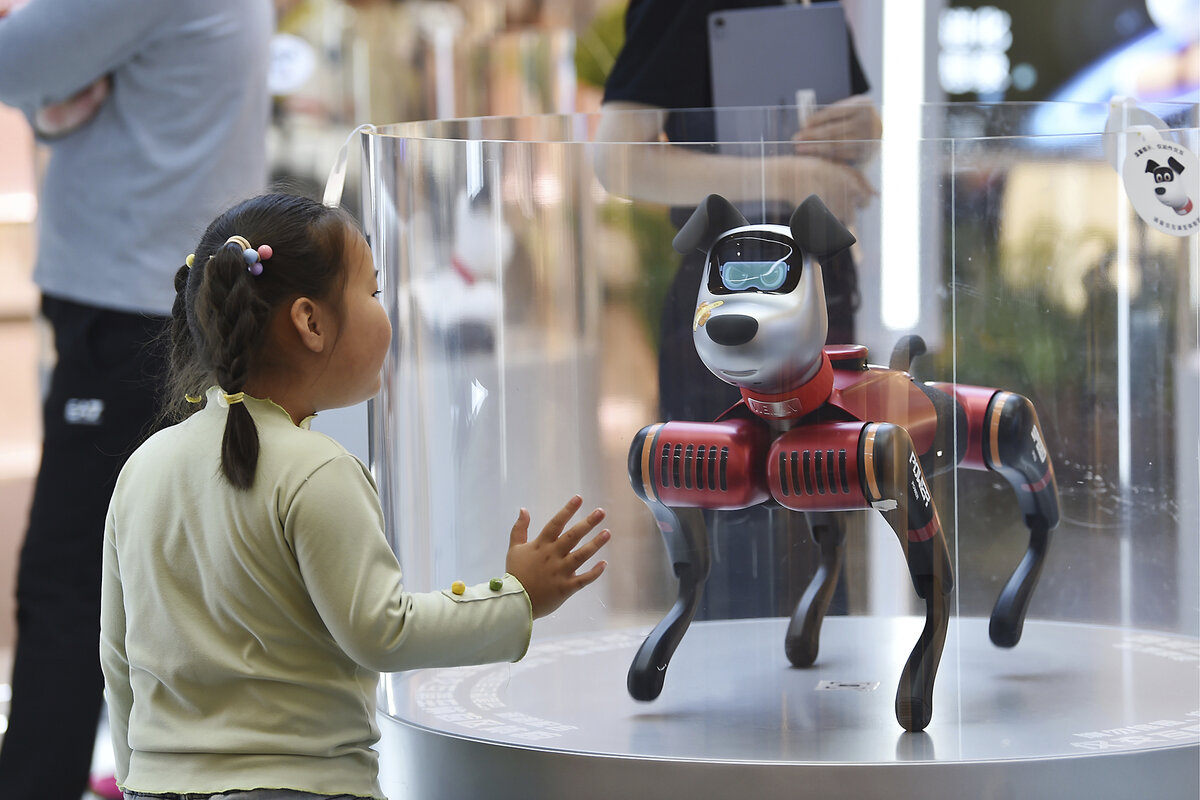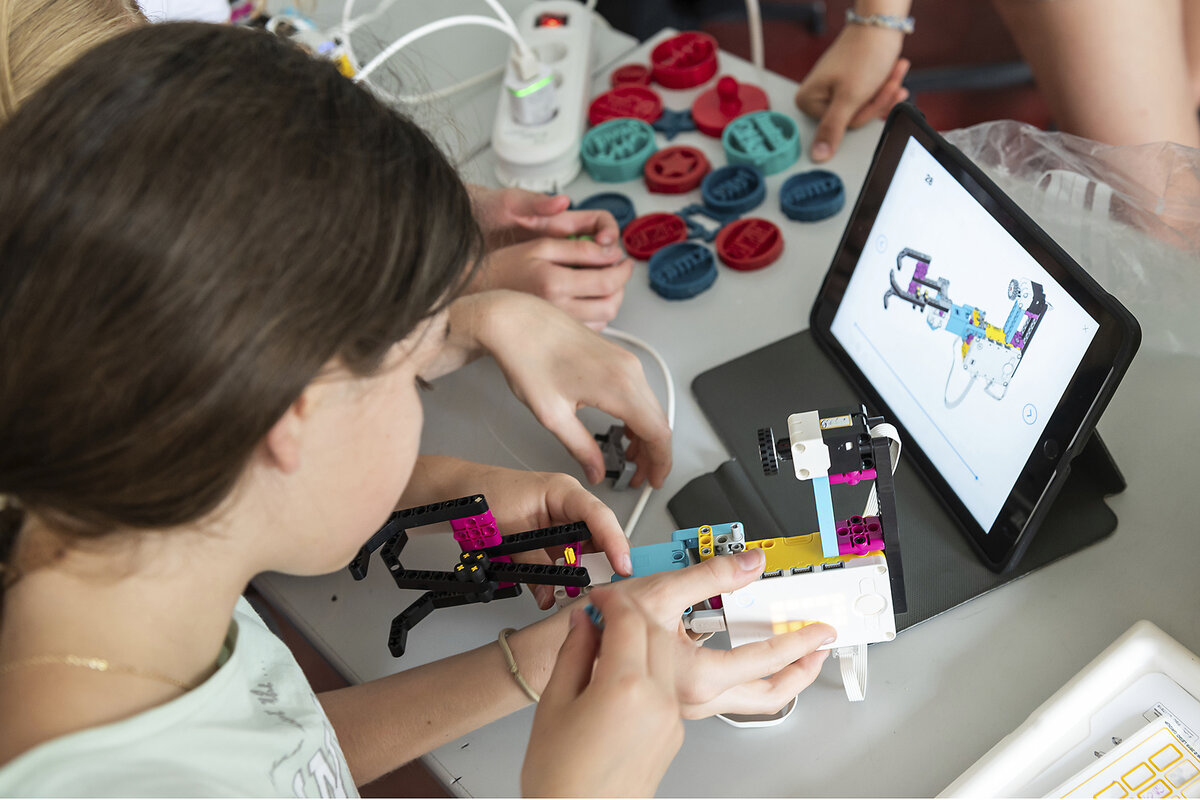Storytelling bears. Wary parents. AI toys step cautiously toward Christmas.
Loading...
The artificial intelligence revolution is headed for Toyland. It may prove a bouncy sleigh ride.
The promise is straightforward: AI can provide toys and games that are ever fresh and help children learn through rich interactions. By , the smart/AI segment of the industry will more than triple its sales to $40 billion by 2032.
But the technology raises concerns about privacy and socialization that have made the industry wary.
Why We Wrote This
Toys and games can help teach children to problem-solve and interact in positive ways with the world. What role will artificial intelligence play in these products? And how can parents and teachers support healthy modern play?
So, AI’s most effective foray into the toy world may be one of stealth: adding capabilities to existing toys as well as creating brand-new ones.
“This holiday season you’ll have ... a handful of good AI-powered toys, but not a ton,” says Robin Raskin, a longtime industry insider. But “Within two years, it’s likely that toys are all going to have some AI component.”
One of the most visible AI toys this Christmas is Poe the AI Story Bear. Children pick the type of story they want – from bedtime stories to superhero adventures – and choose from a slate of characters, and the bear tells a unique story in any of 30 languages.
Sales are good, says Nelo Lucich, CEO and co-founder of Skyrocket, the Los Angeles-based toy company that created Poe. “We’re seeing increases week over week.” But the company has sacrificed interactivity to avoid a backlash from worried parents.
Mistakes with early smart toys
Skyrocket has not activated Poe’s internal microphone, for instance, so children’s voices won’t be recorded or transmitted. But it means that rather than talking to the toy, children have to use a cellphone app to communicate. “We’re trying to warm people up to AI and take less risks on the first product,” Mr. Lucich says.
Companies are proceeding cautiously for several reasons. Any use of the technology requires manufacturers to observe intellectual property rights and privacy laws. And developing guardrails for the toys to keep voice interaction safe doesn’t come cheap.
The industry is still smarting from the debacle a decade ago when companies rushed in with internet-connected toys and ran into a brick wall of public resistance.
Hello Barbie – a pioneering doll introduced in 2015 that could converse, sing, and even tell jokes using an earlier version of AI – didn’t last the year. Mattel pulled the plug after groups complained the doll was recording voices and relaying them over the internet without the children’s or parents’ permission. Another hit doll, My Friend Cayla, ran into a similar privacy maelstrom. In 2017, Germany classified the dolls as “hidden espionage devices” and banned them.
“We secretly call them stupid toys instead of smart toys,” says Stefania Druga, a research scientist for Google Gemini, the company’s AI arm. Too often, companies put technology at the heart of their toys rather than focusing on the child’s play and development, and finding ways that technology can enhance it, she adds.
While many parents fear AI, others are embracing it as a way to help their children learn and cope in an AI age. That interest is buoying niche categories of the toy industry, such as programmable robotics and educational toys.
Two years ago, Lego replaced its Mindstorms programmable robotics system with Spike Prime, which offers children more complex coding. Sphero offers a system to control the movement of everything from a small ball to packs of robots.
It’s not clear that an AI educational toy will make children smarter in the long run, says Randi Williams, program manager at Algorithmic Justice League, a nonprofit working to make AI a positive tool available to everyone. But decades of research has shown significant short-term learning gains.
The future of AI and toys
Mr. Lucich of Skyrocket has more AI products in the pipeline after Poe. The company is focused on toys and games, some of which might appeal to adults’ nostalgia and interest in pop culture. “You could have interactive story-based games,” he says. “You could have a game like Clue, but the scenarios are constantly changing.”
Industry experts and researchers suggest games where a child would play against an AI opponent as well as a slew of companion toys that become increasingly sophisticated.
One worry is that smart dolls and teddy bears could become too good a companion, encouraging younger children to trust too much in a machine and older ones to turn to AI rather than other children for friendship
That’s where parents come in, says Ying Xu, an education professor at the Harvard Graduate School of Education. Teaching children the difference between people and machines will matter – as will limiting access to AI toys that demand a child’s entire attention, she adds. “The toy should actually have a natural stopping point for the kids to end the conversation.”
Another worry: If AI can tell better stories and draw better pictures than children can, will it enhance creativity or crush it? The technology has a definite upside, helping children see patterns and solve problems, says Olivier Toubia, a marketing professor at Columbia Business School specializing in creativity and idea generation. “What’s lacking here is the real human experience.”
Balancing innovation with humanity
Because AI systems known as chatbots don’t live, they lack the creativity that comes from solving everyday problems, and they cannot comprehend the frustrations that can lead to creative breakthroughs, he says. That human element will be needed in the AI age.
In a study of how families were interacting with AI at home during the pandemic, Dr. Druga of Google Gemini made a surprising discovery. “Parents and kids don’t really know how to play with each other anymore,” she says.
Nurturing a child’s human relationships is far more important than finding the right technology, researchers say.
“To the extent that the technologies open up new opportunities for children to design, create, experiment, and explore, then that’s a very positive thing,” says Mitchel Resnick, professor of learning research at the MIT Media Lab. But “Oftentimes AI can be used where the toy comes alive and takes control of the interaction.”
“Play,” recommends Dr. Toubia of Columbia, “and get your hands dirty.”






